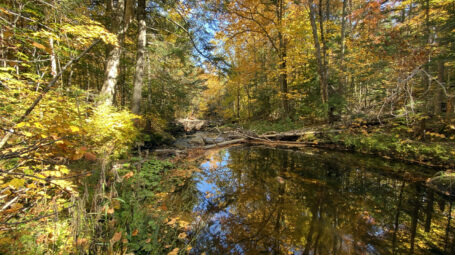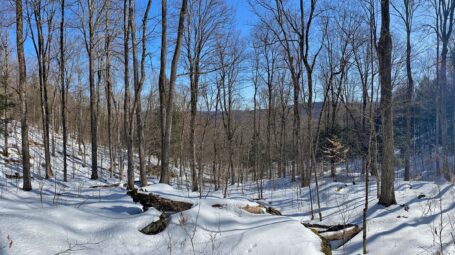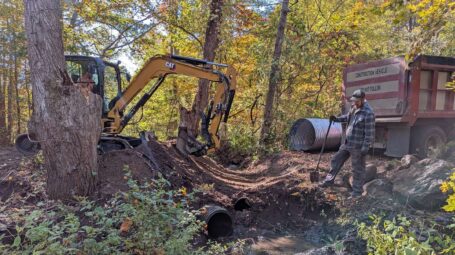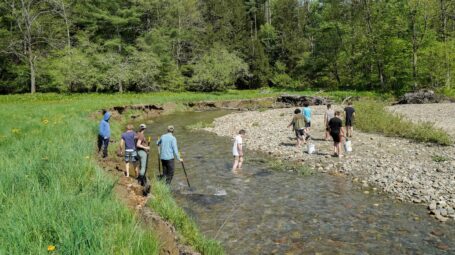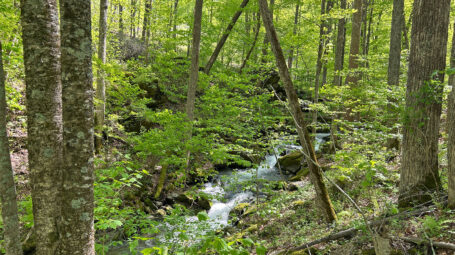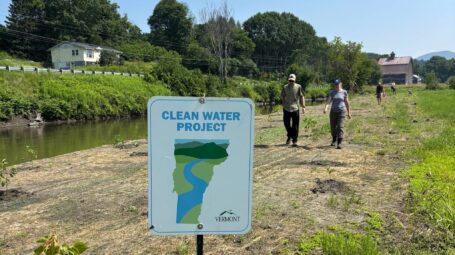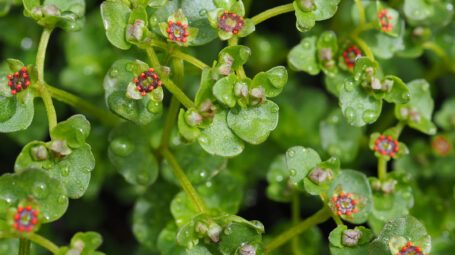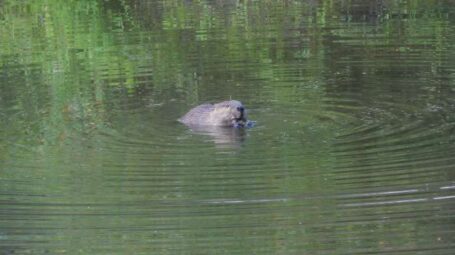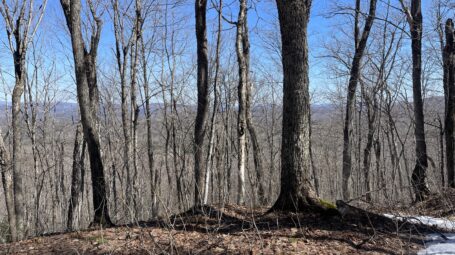Making space for rivers and streams to swell safely during heavy rains
Vermont’s rivers begin on hills and mountains, trickling down slopes before flowing across many a meadow and farm. Straightening streams and rivers and fortifying their banks to redirect and contain water were common practices a hundred years ago. Today, farmers and conservationists alike are paying attention to water on farms in a different way.
Farmers, volunteers, and partner organizations worked with us to plant more than 7,000 trees and shrubs along streams and rivers that cross farmland this year. Spanning over 15 acres in total, the plantings took place along the Lamoille River, Lemon Fair River, Otter Creek, Rock River, Seymour River, as well as a stream that feeds the Winooski River. All these rivers and streams flow ultimately into Lake Champlain.
The plantings are an important part of restoration efforts to improve the health of rivers and streams, reduce flood damage, and improve wildlife habitat. By re-foresting land along Vermont’s waterways, we can do our part to slow flood waters and reduce downstream damage.
Our partners included the Natural Resources Conservation Districts of Addison County, Chittenden County, Franklin County, Lamoille County, and Orleans County, as well as the US Fish & Wildlife Service, Corinth-based Redstart Natural Resource Management, Vermont ECO AmeriCorps members, volunteers from Waterbury-based Ursa Major Skincare, and students from the Monkton-based Willowell Foundation school.
Nearly 1,600 shrubs and trees planted in Franklin County
Rock River, Franklin
Adrian and Marie Rainville partnered with conservation organizations to plant nearly 1,300 bare root trees and 300 willow and alder live stakes on their conserved Franklin farm. The planting took place along nearly a mile of the Rock River that flows across their property. The Rock River flows into Rock River Bay in the northern part of Lake Champlain. The planting was led by the Franklin County Natural Resources Conservation District.
Planting on Orleans County beef farm
Lamoille River, Greensboro
We worked with the Orleans County Natural Resources Conservation District to plant 200 native shrubs and trees along a headwater stream of the Lamoille River. Vermont ECO AmeriCorps members joined in the planting effort. The planting covered half an acre on a farm property in Greensboro Bend that was conserved with us by Ray Shatney and Janet Steward in 2023. Ray and Janet produce 100% grass-fed beef sold under the Greenfield Highland Beef label.
More than 4,000 trees planted in Addison County
Lemon Fair River, Shoreham
We worked with conservation partners and volunteers to plant 675 native trees and shrubs on nearly two acres of former farmland along the Lemon Fair River in Shoreham. The land is on a farm owned by Bill and Lissy Heminway that they conserved with us last year. Students from the Monkton-based Willowell Foundation school joined a three-day planting project for hands-on learning about the landscape and watershed (pictured above and below).
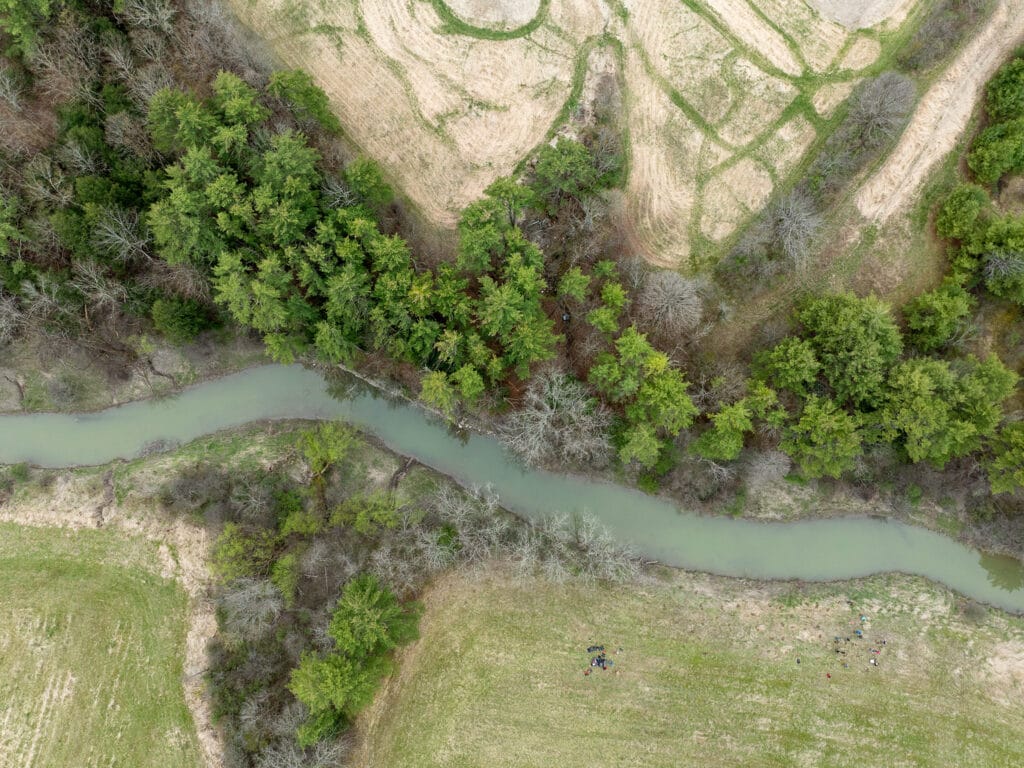
The Addison County Natural Resources Conservation District were key partners who funded the planting and managed several aspects. The US Fish & Wildlife Service worked with us on removing invasive species from the area beforehand, and funded part of the planting. The Lake Champlain Basin Program also provided funding. Silky Dogwood, Bur Oak, Chokecherry, and Paper Birch were some of the native trees and shrubs that were planted.
Otter Creek, Weybridge
We worked with the US Fish & Wildlife Service to plant a total of over 3,500 native trees and shrubs along the Otter Creek and associated streams on two farms. More than 2,000 trees were planted on eight acres a farm that Roger Wales conserved with us two years ago. Roger’s farm sits in the low-lying floodplain of the Otter Creek, just upstream from the creek’s confluence with the Lemon Fair River. The other site was on Dan Kehoe’s conserved farm that is adjacent to Roger’s property. A few years ago, Dan and his wife, Corinne, added special clean-water protections on 34 acres of their already conserved farm. More than 1,400 native shrubs and trees were planted on nearly four acres on the Kehoe farm, along a stream that flows into Otter Creek. These projects were also supported by a Clean Water Service Providers grant from the Vermont Department of Environmental Conservation, and by Corinth-based Redstart Natural Resource Management.
Planting on Chittenden County farm
Muddy Brook, South Burlington
We supported the planting of over 550 native trees and shrubs along Muddy Brook on conserved farmland in South Burlington. Muddy Brook drains into the Winooski and restoration efforts here can support the health and resilience of the Winooski River. The planting was led by the Winooski Natural Resources Conservation District and included volunteers from Waterbury-based Ursa Major. Silky Dogwood, Black Willow, Button Bush, Shrub Willow, Arrowwood, Nannyberry, Swamp White oak were among the trees and shrubs planted here. The farmland is leased by the nearby Bread & Butter Farm, which operates on conserved land as well.
750 native trees planted in Lamoille County
Lamoille River, Cambridge
We partnered with the Lamoille County Natural Resources Conservation District to plant 750 native shrubs and trees on two and half acres along the Seymour River on a conserved farm in Cambridge. The Lamoille County NRCD funded and implemented the project, identifying the appropriate species and organizing the planting itself. The farm, Valley Dream Farm, sits at the base of Mt Mansfield and has a section of the Seymour River flowing through it. Joe and Anne Tisbert originally conserved Valley Dream in 1992, and added special protections for the river last year, which flows into the Lamoille River.
Funding note:


